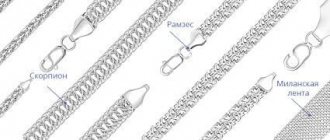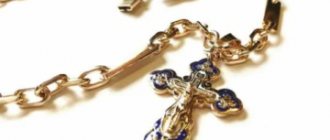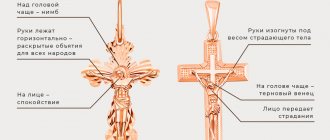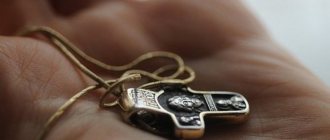The cross is an indicator of belonging to the Christian faith. From this article you will find out whether it is possible to wear someone else’s cross, and why it cannot be worn over clothes.
The cross, according to the clergy, should always be on a believer. But there are also prohibitions associated with it. Some of them are nothing more than superstitions that a believer should not even think about. These include, for example, the darkening of the cross. But this is far from the only question that a believer may have about his cross.
You cannot wear an unconsecrated cross
It is best to consecrate the cross. But as such, there is no prohibition on wearing an unconsecrated cross. It is believed that evil spirits avoid even two crossed sticks. Nevertheless, a believer should still consecrate his symbol of faith. You can choose any cross you like: gold, silver, copper or wood. The material is not very important. It is important to consecrate it and not wear jewelry purchased at a jewelry store as a cross. It is necessary to understand that the church Orthodox cross, which symbolizes faith in God, differs from beautiful, but purely decorative crosses. They do not carry a spiritual load and have nothing to do with faith.
Why should I go to church if I have faith in my soul? Why wear a cross if I’m already a Christian? Is it really written in the Gospel that everyone should wear crosses? So to wear or not to wear? Similar questions are often asked by unchurched people.
Let's try to answer.
External features and selection criteria
A pectoral cross is primarily a symbol of the Christian faith, and not a beautiful piece of jewelry. Pectoral crosses have always been distinguished by a variety of shapes and materials from which they are made - gold, silver, copper, bronze, wood, bone, amber.
There are quite a few options for the decoration of Orthodox crosses. They can be with sharp and rounded ends, with straight and tilted crossbars, with a rhombus or a square located in the middle. On many products you can find floral patterns.
The Crucifixion of Christ also differs in type. Making a church symbol:
- eight-pointed;
- seven-pointed;
- in the form of a crown of thorns.
The cross with eight ends is considered the most popular. The seven-pointed piece is often used for divine images created in the 15th century. The crown of thorns is made in the form of a cross with a thorny crown, denoting the suffering and torment of Christ.
Pectoral crosses for men and women differ in appearance. The latter are made with a more rounded and smoothed shape, without sharp corners that are found on men's versions of products.
When choosing an Orthodox symbol, you must adhere to certain rules. There should not be anything on it that could desecrate God, and the presence of symbols of other religions or pagan signs is also unacceptable. On a correctly executed cross, the Savior should seem to be lying on top of the crucifix itself, without sagging the body and throwing back the head.
The material from which the Christian symbol is made plays an important role. It could be gold, which represents truth. Crosses made of wood are popular, symbolizing the Tree of Life in the Heavenly Kingdom. Silver is considered the personification of chastity and purity.
Where did this tradition come from?
Wearing a cross without a real Christian life will look like some kind of fake. Treating the cross as a beautiful decoration will also serve to condemn a person. So what happens: you can’t wear it, otherwise you’ll harm yourself?
Wearing a pectoral cross is not only possible, but also necessary. Many believers can confirm: this is the most powerful protection for a person. Why? Because the cross is the instrument of Christ's death. The crucified Jesus washed away the sins of every person with His Blood.
Therefore, this reminds every Christian of the sacrifices God makes for man, for which Christ suffered. If Jesus had not suffered, the people would have had no hope of salvation. The cross is rightly called the instrument of our salvation. But many people refuse to wear this item on their body.
Among the arguments, the most popular are:
- this in no way confirms that I am a Christian;
- There are no indications in the Gospel about wearing a cross; the first Christians did not know this either...
Yes, indeed, wearing a cross on a pectoral cross without practicing Christian life is reminiscent of a person trying to sail on a wreck of a ship in a storm.
Indeed, the Gospel and the lives of the early Christians do not indicate that people supported modern practices.
But in the life of the early church there was a custom of wearing medallions with the image of the slain Lamb or the Crucifixion. Sources from the 2nd century indicate: some Christians already had crosses or painted them on their foreheads in order to “give themselves away” to their persecutors and suffer for their faith. When the “hunt” for believers subsided, the pious example of the early Christians spread widely.
An interesting historical fact is given by Archpriest Igor Fomin.
There was one rather humiliating custom in the Roman Empire. Just as we now put a collar on dogs, their slaves wore the same straps around their necks indicating the name of their owner.
The first Christians, opposing themselves to such a society, wore crosses, as if saying: we do not belong to you. We have another Master who paid for us with his own life.
Why didn't Christians depict Christ on the cross?
One of the oldest surviving images of the crucified Jesus Christ is on the door of the Basilica of Santa Sabina, a church on the Aventine Hill in Rome. It dates back to the 5th century. Before this, Christians did not depict Christ on the cross. Even the so-called crux gemmata - a cross decorated with precious stones, but without the figure of the crucified Christ - appeared only in the 4th century.
Christians avoided depicting the cross. Not so much because it was prohibited, but because of the controversial nature of the symbol. After all, for at least two centuries after the coming of Christ, along the roads of the Roman Empire there were crosses with crucified slaves dying a painful death. So the cross was a very ambiguous symbol, raising questions.
Spiritual protection
Today it is customary to put a cross on a person after performing the Sacrament of Baptism. This is a confirmation of my involvement in the Church and the understanding that the Son of God suffered for my sake.
Yes, all this is nonsense! Why wear a cross? - the skeptic will say. — Just think: two wooden sticks or a metal figurine. Can they protect a person?
The answer is very laconic: they can. A lot of evidence can be found.
For example, during difficult Soviet times, it was forbidden to wear “metal figures.” If a girl is going to marry a man of other faiths, she is usually required to remove... her cross. It goes something like this: renounce your faith, turn away from Christ.
And how many stories there are about how, without a cross, people were deprived of spiritual protection! Many became possessed - they were possessed by evil spirits. And when someone approached them with a cross, they began to cower, scream, curse, and bang their heads against the wall...
Symbol of victory over the devil
A priest I knew told an incident from his own practice. He served in a village where everyone knew each other. There lived one man who had little contact with people and had no family. He never went to church.
One day the priest passed by this man. For some reason I decided to stop and talk. Then he says:
Alexey, I want to give you a small gift.
The man was as happy as a child. The priest placed a pectoral cross on his neck.
Some time has passed. The abbot and Alexei met again. The man, almost in tears, said:
Father, I couldn’t accept your gift.
And he told the story. After they hung a cross on his neck, he did not understand what was happening to him. When I came to my senses, I realized: he was already far from home, on the local Bald Mountain. There was no longer a cross on the neck.
No matter how skeptical we are about this, we certainly don’t know what power this symbol of Christianity has. Therefore, the evil one tries to hinder a person in various ways.
Why wear a cross? To protect yourself. The devil is afraid of losing access to a person, worries that he may take the path of piety and be saved. After all, the cross is a symbol of victory over the forces of darkness, a constant reminder of who we are, why we were created and how to be saved.
Is it necessary to have a cross nose on the neck?
The biggest misconception of people who consider themselves Orthodox, but deliberately allow themselves many acts in the phrase “I believe in God in my soul, but I don’t need a cross. It is not written anywhere in the Bible that one must wear a cross, and nowhere is it written that the first Christians wore crosses.” Symbols are just symbols, nothing more.
But... There is a proverb: “Demons hide in small things.” So, for those for whom wearing a cross is a trifle, demons celebrate their victory in the goal of turning him away from Orthodoxy. “To prevent a shooter from hitting the target, it is enough to knock the sights off by a hair.”
Indeed, in the first centuries after the Nativity of Christ, some Christians did not wear the cross, but wore it with the image of the slain Lamb (this image is still found in Armenian churches and Orthodox churches) or the Crucifixion. Nevertheless, already at that time, it was common among the first followers of Christ to always carry an image of the cross with them - both as a reminder of the suffering of the Lord Jesus Christ, and in order to show themselves as a participant in Christianity.
So, the Cross of Christ is a visible symbol of Christianity.
By wearing a pectoral cross, a person spiritually swears that he is Orthodox. This is comparable to a military man who has sworn allegiance to his homeland and wears the corresponding chevron.
Words of the Lord Jesus Christ: “If anyone wants to come after Me, let him turn away, and take up his cross, and follow Me.”
(Mark 8:34). Here is another reason for wearing a cross. We show God that we carry our cross.
Should a pectoral cross be blessed?!
Of course! Moreover, a clergyman. You will not consecrate a store-bought cross by simply sprinkling holy water on it at home.
What to do with a cross on your neck?
Firstly, wear it. Wear it on your chest (on your body), and not in a bag or purse. The cross should always be on the body, closer to the heart) First of all, always remember it. This is a symbol of belonging to faith, culture and memory of ancestors. If you have a cross on, then you profess Orthodoxy, and you should behave accordingly.
The Pskov-Pechersk elder Savva said: “Do not wear a cross as if on a hanger, ..... Rays of blessed light and love emanate from the cross. The cross drives away evil spirits. Kiss your cross morning and evening, do not forget to kiss it, inhale these rays of grace emanating from it, they invisibly pass into your soul, heart, conscience, character. Kissing your cross, pray for close sinners: drunkards, fornicators and others you know. Through your prayers they will improve and be good, for the heart gives the message to the heart. If you start the day like this, overshadowed by grace from your cross, then you will spend the whole day holy. Let's not forget to do this. It’s better not to eat than to forget about the cross!”
A pectoral cross is not an amulet! And you can’t show it off. Wearing a cross is internal, personal, spiritual. You cannot go to Confession and Communion without a pectoral cross.
Is it possible to remove a pectoral cross?
Any removal of the pectoral cross can be regarded as a renunciation of faith. Over the more than 2000-year history of Christianity, many people have suffered for their faith, for refusing to renounce Christ and take off their pectoral cross. For example, the feat of Yevgeny Rodionov, who did not remove the cross in Chechen captivity in exchange for pardon. He knew that for refusing to remove the cross his head would be cut off. He did not remove the cross and was executed. By the way, even from the dead, beheaded Eugene, the enemies did not dare to remove the cross. The great Russian elders said that one must always wear a pectoral cross and never take it off anywhere until death.
What to do if the cross is lost?
If you have lost your pectoral cross, then you urgently need to buy a new one to put on your neck (consecrated, of course).
If you take off your cross and “lose” it, it could be the leprosy of demons (a consecrated cross on your body contains prayers
, and therefore protection from demons).
Should young children wear a cross? Necessarily, since young children are spiritually defenseless. The demon through TV, friends and other moments can instill very dangerous things in your child.
What should you do if you find an unknown cross?
You don't have to do anything. The pectoral cross can contain either the priest’s prayers or “grandmother” spells. It’s better not to take risks, since with someone else’s pectoral cross you can take the worst from someone else’s fate.
By the way, anyone who has not been baptized cannot wear a pectoral cross, since a cross is not a decoration, but a symbol of belonging to Orthodoxy!
A pectoral cross - why is it worn on the body and is it possible to remove the cross from oneself?
BODY CROSS
Of all the world religions, Christianity occupies a special position in Russia. According to statistics, at least two thirds of Russians have received the Sacrament of Baptism. In this Sacrament, among other actions, a pectoral cross is placed on a person’s neck. About where the tradition of wearing crosses on the body came from, why it is worn on the body and whether it is possible to remove the cross from oneself - this and other things will be discussed in our article.
A little history
The custom of placing a pectoral cross on the neck of the newly baptized person along with Baptism did not appear immediately. However, the cross as an instrument of salvation has been the subject of greatest celebration among Christians since the very foundation of the Church. For example, the church thinker Tertullian (II-III centuries) in his “Apology” testifies that the veneration of the cross existed from the first times of Christianity. Even before the discovery of the life-giving cross on which Christ was crucified in the 4th century by Queen Helena and Emperor Constantine, the custom was already widespread among the first followers of Christ to always carry an image of the cross with them - both as a reminder of the suffering of the Lord, and to confess their faith before others . From the acts of the 7th Ecumenical Council (act 4) we know that the holy martyrs Orestes (suffered ca. 304) and Procopius (martyred in 303) wore a cross on their chests. Pontius, the biography of the holy martyr Cyprian of Carthage (d. 258), and others also write about this custom. Christians wore an image of a cross on their bodies, most often on their foreheads and chests. If some Christians wore a cross under their clothes out of fear of persecution or out of a reverent desire to avoid ridicule of the shrine by pagans, then there were others who wanted to confess Christ and their faith. Such a bold and decisive confession prompted the image of a cross to be placed on the forehead as the most prominent place on the human body. Today very few external sources have survived that would report on this pious tradition of wearing the cross, because in the first three centuries it belonged to the area of disciplinae arcanae, that is, to the circle of those Christian beliefs and rituals that were kept secret from the pagans. After the weakening and subsequent cessation of the persecution of Christians, wearing a cross became a widespread custom. At the same time, crosses began to be installed on all Christian churches. In Rus', this custom was adopted precisely with the baptism of the Slavs in 988. On Russian soil, crosses were worn not on the body, but on top of clothing, “as clear indicators of Christian baptism.” They were called encolpions - from the Greek word for “chest”. Encolpions first had the shape of a four-sided box, empty inside; on their outer side there was an image of a monogram of the name of Jesus Christ, and later - a cross of various shapes. Particles of relics were kept in this box.
The meaning of the cross
What does a pectoral cross symbolize and why is it necessary to wear it? The cross, as an instrument of terrible and painful execution, thanks to the sacrificial deed of Christ the Savior, became a symbol of redemption and an instrument of salvation for all mankind from sin and death. It is on the Cross, through pain and suffering, death and Resurrection, that the Son of God accomplishes the salvation or healing of human nature from mortality, passion and corruption introduced into it by the fall of Adam and Eve. Thus, a person who wears the Crucifixion of Christ testifies to his participation in the suffering and feat of his Savior, followed by hope for salvation, and therefore the resurrection of a person for eternal life with God. This participation consists not so much in theoretically recognizing that Christ once, more than two thousand years ago, suffered physically and morally in Jerusalem, but in accepting: I, just like the Lord, am ready to offer daily sacrifice yourself - through the struggle with your passions, through forgiveness and non-judgment of your neighbors, through building your life according to the Gospel commandments of the Savior - as a sign of love and gratitude to Him.
A huge honor
For an Orthodox Christian, wearing a cross is a great honor and responsibility. Conscious disregard and blasphemous attitude towards the cross among the Russian people has always been understood as an act of apostasy. Russian people swore allegiance on crosses, and by exchanging pectoral crosses, they became cross brothers. When building churches, houses, and bridges, a cross was laid in the foundation. The Orthodox Church believes that through a person’s faith, the power of God is manifested (acted) in an invisible way through the cross of Christ. The cross is a weapon against the devil. The Church can reliably speak about the miraculous, saving and healing power of the cross and the sign of the cross, citing experience from the lives of its saints, as well as numerous testimonies of ordinary believers. Resurrection of the dead, healing from illnesses, protection from evil forces - all these and other benefits to this day through the cross show the love of God to man.
Worthless superstitions
But despite the life-giving power of the cross, many people believe (follow) various superstitions associated with the cross. Here is an example of one of them: “Seeing a pectoral cross in a dream is an alarming sign, and if you dreamed that you had lost a cross, be prepared for troubles that will not be slow to fall on you,” dream interpreters unanimously say. But the most common superstition associated with the Crucifixion tells us that if we find somewhere a cross lost by someone, then we cannot take it, since by doing so we are taking on the sins of others. However, when it comes to finding lost money, no one remembers the sins of others, especially the pain of others. And to the “serious question” that worries many people about what it means when a cross is lost, I would like to answer just as seriously that it means that the chain or rope on which this cross hung was broken. The presence in a person of a superstitious, that is, vain, empty attitude towards the cross testifies to a lack of faith and even distrust of Christ, and therefore of His redemptive sacrificial feat accomplished on the Cross. In this case, hope and love for God and trust in God's Providence are replaced by distrust and fear of the unknown.
Dubious goals
For what purpose are crosses worn today and are they worn at all? Here are the answers to this question that were posted on one of the Internet forums: . I wear it as a talisman; . because it’s beautiful and probably just helps; . I wear a cross, but not as a symbol of faith, but as a gift from someone close to me; . I wear it because, they say, it brings happiness; . I don’t wear it, because I consider it idolatry; there is no indication of this custom in the Bible; . I don’t wear a cross for two reasons: my neck itches terribly from all these chains, and secondly, I, of course, am a believer, but not to the same extent... This is exactly how unchurched people with a pagan, or even consumerist, attitude towards faith and religion reason . But among this type of people there is a part that does not accept wearing a cross at all, citing the following reason: “God is already in my soul”; “In the Bible, God does not command you to wear a cross”; “The cross is a symbol of death, a shameful instrument of execution,” etc. What can a person come up with as an excuse for his elementary ignorance in the field of Christian culture! Thus, most unchurched people do not have a Christian understanding of what a cross is and why it should be worn on the body. The Church says that the cross is a shrine on which the salvation of people was accomplished, testifying to God’s love for us. Upon acceptance of the Sacrament of Baptism, a person begins to be called a Christian, which means one who is ready to testify to loyalty to God with his whole life through bearing his life’s cross and following His commandments. This is precisely what the image of the cross on our chest constantly reminds us of. Orthodox Christians are called upon to look at the cross and treat it with great reverence and responsibility. Such reverent attitude towards the cross and remembering it as a shrine often keeps a person from committing a bad act. It is not for nothing that in Rus' a person who committed a crime was told: “You have no cross.” This phrase does not carry the literal, physical meaning of the absence of a cross on the body, but speaks of a lack of remembrance, a serious Christian attitude towards the cross and the Christian faith. In itself, the presence of a cross on the chest does not save and has no meaning for a person if he does not consciously profess what the Cross of Christ symbolizes. A reverent attitude towards the body cross encourages a believer not to remove the cross from the body unless seriously necessary. The fact that in Rus' they made special bath crosses from wood, so as not to get burned by a metal cross, suggests that people did not want to remove the crosses even for a short time (during washing). No wonder the Russian people said: “He who has a cross is with Christ.” But there are situations when certain circumstances require it - for example, operations on the body. In such cases, you should not neglect the doctor’s request; it is enough to sign yourself with the sign of the cross and rely on the will of God. The question of whether or not to put crosses on infants causes fear in many people, because the child allegedly could be strangled by the rope or chain on which the Crucifix is located. But there is not yet a single known accident in which a child strangled himself with his own hands or inflicted wounds on himself with a cross. These are just vain fears or superstitious prejudices of adults. My only advice to parents is that they should not put too long a rope or chain around their children’s necks. Conclusion The cross is not just a memory of the day of baptism and not a relic that should be kept, not a talisman or a gift, but a shrine through which God gives a believer who leads a correct spiritual life His grace, consolation and support. It is no coincidence that the Russian people have put together a wise proverb: “We do not bear the cross, but it bears us.” Being a visible shrine, the pectoral cross is designed to testify to our faith in Christ, our readiness to sacrificially love and forgive people and live according to the Gospel commandments. And may God grant us, looking at our cross, to more often remember the words of the Lord and act according to His call: “If anyone wants to come after Me, let him deny himself and take up his cross and follow Me” (Matthew 16:24).
Deacon Konstantin Kiosev
Why do you need to wear a cross?
The cross on the body is a visible expression of the fact that we are Orthodox Christians. Like soldiers, they wear stripes that indicate the branches of the military to which they belong - some for artillerymen, others for pilots, others for border guards. Nurses wear a red cross on their headscarf as a sign that they are doing charity work. There are badges of orders. Suppose a person is awarded an order, and everyone who has such an order is given a special badge that can be worn instead of the order. The sign means that people who have it belong to a certain community and are united by profession or by their services to the Motherland.
We, Orthodox Christians, are gathered around the Cross of the Lord. And the person who puts the Cross on himself says: “I am a Christian.” When we were all baptized, the priest put white shirts on us as a sign of purity and holiness, and then a cross along with the words of the Savior: “Whoever wants to follow me will take up his cross and follow me.” We must bear our cross in life, and the cross that is on our chest reminds us of this. Resurrection in eternal life can only be achieved by bearing your cross. You can’t get to eternal life by trolleybus, much less in a soft taxi, you can only get there through labor and effort. The Lord says: “Whether we want it or not, the kingdom of heaven is achieved through effort.” He who makes efforts reaches the kingdom of God. The cross is a reminder to us of this.
My godson, when he was cutting his teeth, gnawed on his cross and chewed off half of it. it was removed and put into a box. But it’s impossible without a cross? What if I buy him a new one? Katerina
Dear Catherine, it is prudent to let a small child wear a cross from the time when he understands what a cross is, at least within the limits of a child’s faith. However, giving it to a baby, for whom a cross is just an object that can be put in his mouth along with a pacifier and toys, is both unreasonable and unsafe. It would be more correct to hang a cross above his crib or next to the icons.
My child received a cross as a christening gift, but I am a little confused by its shape. It is 4-pointed, and the bottom edge is sharp, shaped like a dagger (My cross has rounded ends). I'm afraid that the child may stumble upon this end. Is it necessary to wear it all the time (the baby is 2 months old) or is it better to change the cross? Ksenia
Dear Ksenia, of course, buy your child a normal, traditional eight-pointed cross. In general, such a small child needs to wear a cross when you take him to church and give him communion. And let him hang it above his crib. Let the child begin to wear a cross regularly when he begins to understand what it is, that it is a symbol of our faith, and not a toy that can be stuffed into his mouth.
Is it possible to wear an amulet with the image of Jesus Christ, but not wear a cross; will it protect from adversity? Or should I wear both at the same time? Larisa
Dear Larisa, the cross is a symbol of our salvation. An Orthodox Christian should not wear any amulets or amulets. In the same way, if an object with Christian symbolism is treated as an amulet, this will in no way benefit our soul.
Since childhood, I remember well that you cannot show your pectoral cross to other people, so you need to hide it under a jacket, etc. Please tell me if this is correct and what is the reason for this? And what should I do if my cross is visible in my photo posted on the Internet? Alla
Dear Alla, the cross on the body is a visible expression of the fact that we are Orthodox Christians. We, Orthodox Christians, are gathered around the Cross of the Lord. And the person who puts the Cross on himself says: “I am a Christian.” When we were all baptized, the priest put white shirts on us as a sign of purity and holiness, and then a cross along with the words of the Savior: “Whoever wants to follow Me will take up his cross and follow Me.” We must bear our cross in life, and the cross that is on our chest reminds us of this. Resurrection in eternal life can only be achieved by bearing your cross. The pectoral cross is a reminder to us of this. A reminder to us, not to everyone around us. In addition, you should not wear a cross as a decoration, for show. Leave the photo on the Internet as it is, and from now on wear the cross under your clothes.
The meaning of the amulet is not entirely clear. For some reason it is associated with some kind of talisman, like a talisman. It is also incomprehensible that people who do not belong to the clergy use a belt with the 50th psalm and the prayer “May God rise again” as an attribute of clothing. Irina
I would rather be surprised at the use of Psalm 50. More often, Psalm 90 is worn, “He lives in the help of the Most High,” rather than Psalm 50 and the prayer “May God rise again.” So, it is surprising if this belt is used by non-believers or non-Orthodox people, which is sometimes seen, for some superstitious reasons. This is, indeed, a completely inadequate use of objects consecrated in the church tradition. One should wisely use certain material shrines, be it, as our pious ancestors wore, a cross with a particle of relics, or a belt with the words of a prayer, or an amulet in which, say, earth from the Holy Land is sewn, or a pebble from the Holy Land, with the mountains of Golgotha, where the Lord once destined us to visit. And these shrines must be used not out of superstitious fear - as if something would not have happened without them - but remembering that man is a spiritual-physical being, that not only our soul, but also our bodily composition needs not even protection, but sanctification . That the belt that girds your loins, on which your gaze will rest in a moment of temptation, will protect you from other sins. And then it will become clear that the use of holy objects is not so meaningless. Well, let’s say, will a person going to sin be able to cross himself and kiss his pectoral cross? It is probably no coincidence that those who seriously sin try to remove the cross from themselves, or hang up icons, or close the door in a cabinet if they want to do something evil at home. The presence of a shrine near us is something sanctifying.
I heard that a cross for a baby’s baptism should either be donated by the godparents or bought by the child’s mother, but not given by other people, even relatives. Is it so? Kira
Dear Kira, the godfather can give the godson, for example, a baptismal cross, or a silver spoon (there was such a tradition) “for the first tooth,” you can give an icon of the saint whose name the baby bears, or something else, but the main purpose of the godfather is to help parents, and not only in everyday needs, but also to responsibly and prayerfully participate in the Christian upbringing of the child.
I was invited to become a godmother. I want this, but I am worried about this responsibility. In a religious sense, I am not very educated and my problem is that I don’t know how a godmother should behave, what she can give, etc. I would like the gift for the child to remain for a long time, and I behaved like a godmother worthy, please help me! Alyona
Dear Alena, being a godmother is both an honor and responsibility. The godmother and father, participating in the Sacrament, take responsibility for the little member of the Church, for ensuring that he grows up as a worthy and believing person, and that the actual baptism of the baby is performed according to the faith of the godparents. Therefore, godparents must be Orthodox, church people. Based on all this, it is appropriate to behave accordingly.
What to give - the godparent can give the child a cross, or a small silver spoon “for the first tooth,” or an icon of the saint whose name the baby bears, or something else.
Not all people think about why they should wear a cross. For some it goes without saying, but for others it is an obligatory attribute of faith. But once you figure it out in order, why wear an Orthodox cross?
First of all, the cross is the main symbol of the Orthodox faith. As a rule, it is worn on the chest. The material from which the cross is made does not matter. It can be gold, silver, ordinary wood. Orthodox crosses can be of different sizes, volumes (flat and with more convex shapes), decorated with semi-precious stones or precious ones, or without stones at all. Clergymen have everyday crosses and holiday crosses.
Every Orthodox believer is required to wear a cross. In this way, he does not demonstrate his involvement in a certain faith, but becomes closer to God. The display of crosses (wearing them over clothing) is not approved by the church. The male cross is different from the female one. As a rule, it is larger and more massive. The pectoral cross should be hidden under clothing and be “closer to the body.” Symbols of faith made from high-quality precious metals do not cause allergies, so even children can safely wear such jewelry. The Church does not regulate the material from which the cross should be made. You can wear it on your chest from precious metals, for example, platinum or gold, as well as from other materials, for example, wood.
So why do Orthodox Christians wear a cross?
If you want to get a more detailed answer to the question of why Orthodox Christians wear a cross, then you’d better contact the priest at church. But overall there are a few main points. First of all, Orthodox Christians wear a cross around their necks in order to be closer to God. Secondly, all believers believe that a pectoral cross consecrated in the Temple saves from evil glances, words, thoughts, and protects from illness. In difficult times, a believer can always turn for help to the symbol of faith that is around his neck. You can buy a pectoral cross in the Orthodox online store at pravzhizn.ru. The assortment includes products made from various semi-precious and precious metals.
Usually the pectoral cross is hung on a chain made of the same metal from which the symbol of faith itself is made. But many believers wear crosses on a string. For a woman, it is worth choosing a pectoral cross and a chain made of the metal from which all her jewelry is made. For example, if you wear a gold cross, then the chain, rings and earrings should also be made of gold. Do not mix gold and silver jewelry.
Signs associated with the pectoral cross
For any believer, a pectoral cross is the most powerful amulet. There are many signs associated with it, which are partly just superstitions, but there is some truth in some of them.
- Wearing someone else's cross will lead to poaching the fate of its previous owner. This is a myth invented by grandmothers who do not know about the true purpose of the pectoral cross. This is, first of all, a shrine and therefore cannot harm a person in principle.
- You cannot pick up a cross that someone has lost from the ground. This statement is true because... such things are often damaged and picking it up can get you into trouble.
- A darkened cross is a bad omen. This means that a magical influence was exerted on the person, and he became a victim of the evil eye and damage.
- If the chain on the cross breaks on its own, without any mechanical action, this means that trouble is coming. In this case, it is recommended to reconsider your views on life, repent of your mistakes and ask for forgiveness from those people who were hurt.
Cannot be worn on a chain
There are absolutely no restrictions on the chain. Here, rather, the more important question is convenience and habit. If a person wants to wear a cross on a chain, he can do so; the church does not prohibit such actions. The most important principle to follow in this case is that the cross does not get lost and does not fly off the neck. Both lace and chain are acceptable. Superstitious people, however, claim that by all accounts the cross is not lost just like that.
Can't give
You can always give a cross. Of course, it’s great if parents or godparents take care of this as one of the christening gifts. But this does not mean that another person cannot give you a cross. There is also a tradition when two people exchange crosses, becoming brothers or sisters in Christ. Usually this is done by close people.










